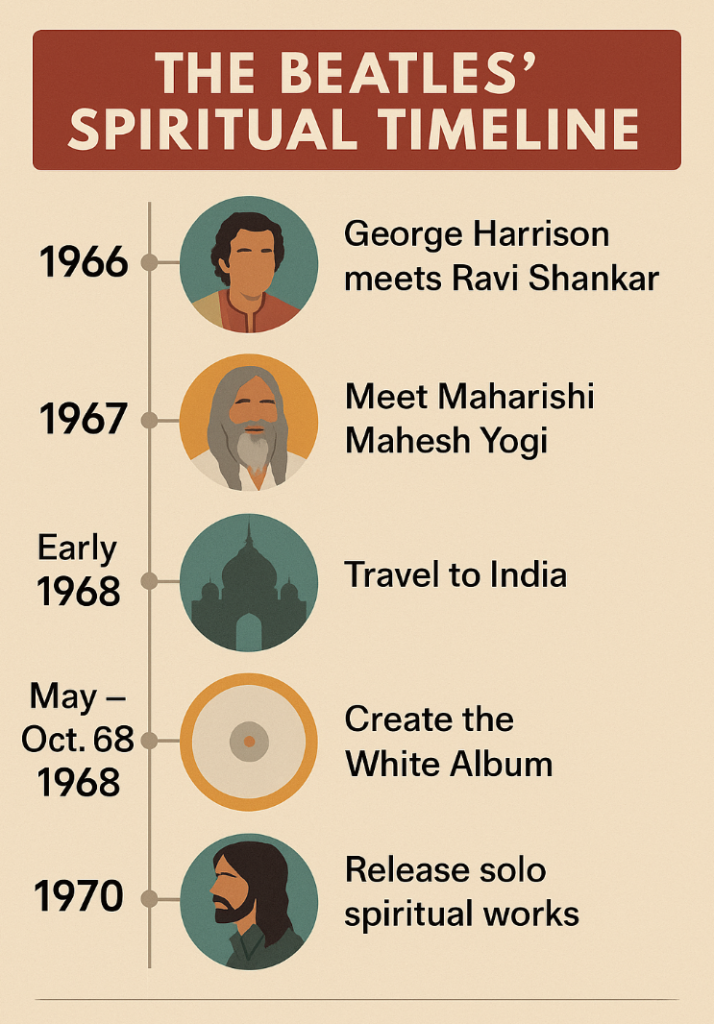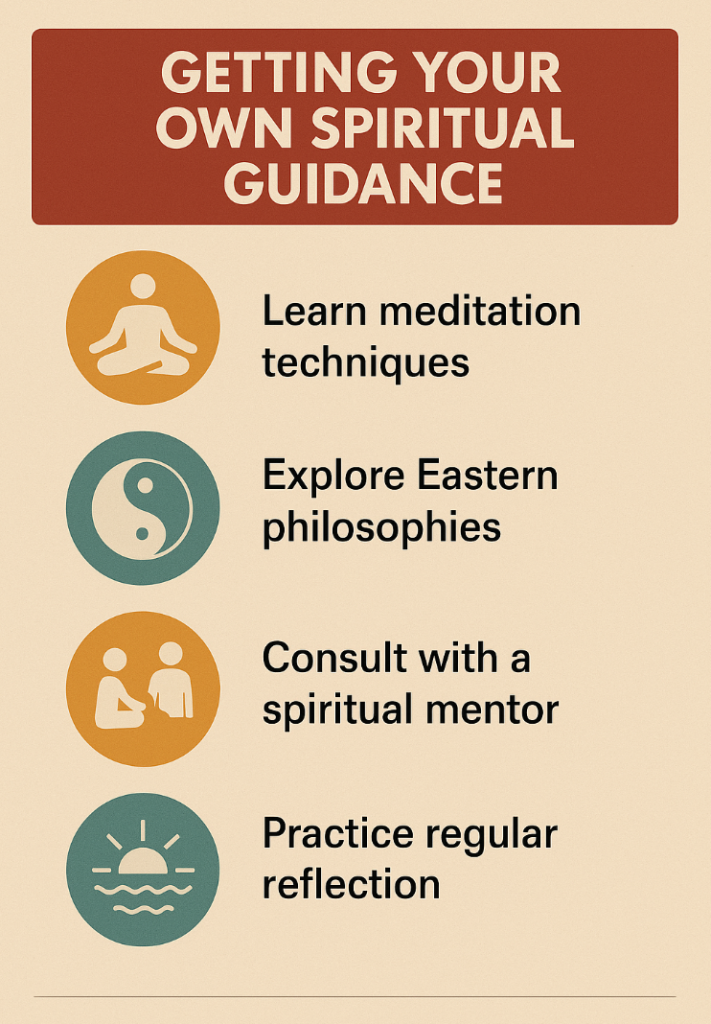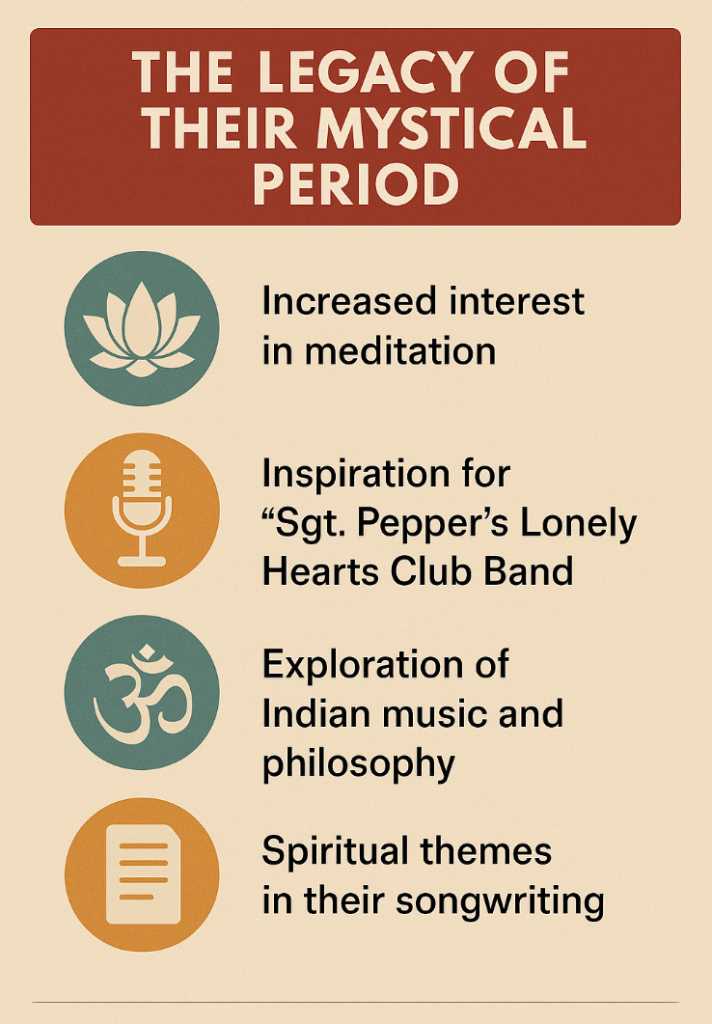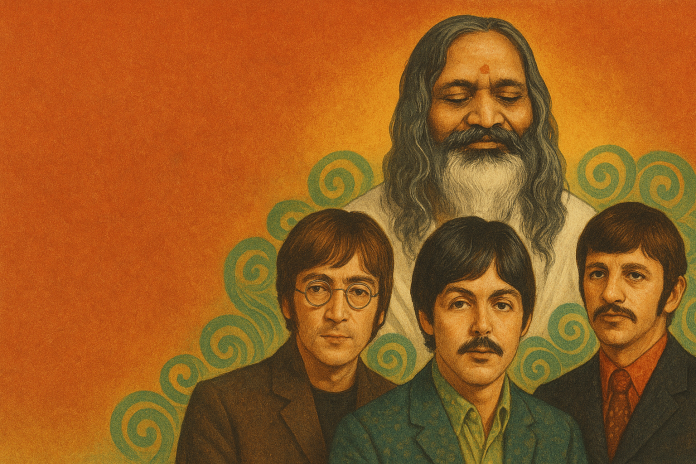Beatles: More Than Just Rock Stars
The Beatles weren’t just the biggest band in the world in the late 1960s, but they were the ones that were shaping fashion, politics, music, and even spirituality. But by 1967, after years of touring non-stop and the different media outlets, the Beatles got tired of just being celebrities. What could happen to the four men who seem to have everything?
The Beatles didn’t just have a record executive or a producer; they had mystics who were thousands and thousands of miles away. The Beatles looked into Eastern spirituality, and this caused them to go to the famous retreat with Maharishi Mahesh Yogi in India. This wasn’t just about a personal journey, but it helped to change their career path, their music, and even their own public images.
The effects of consulting mystics were beyond what anybody would believe. When they made this choice, they immersed their lives in meditation and spiritual guidance that helped them to take time to pause, reset, and then to produce some of their best work. When their intuition, mysticism, and music worked together, it led them to a life of never-ending music history.
The Beatles in India: The Retreat That Changed Their Music and Themselves
In 1968, at the height of their fame, the Beatles did something no one expected. Instead of chasing another record or tour, they packed up and went to India. They weren’t looking for a new sound or a hit single. They were searching for peace. The group traveled to Rishikesh to study Transcendental Meditation with Maharishi Mahesh Yogi, a decision that would forever shift the way they made music and saw the world.
Their interest in the Maharishi started a year earlier, after attending one of his talks in Bangor, Wales. What began as curiosity grew into something much deeper. By the time they reached India, they were ready to step out of the chaos of fame and spend real time learning how to quiet their minds. It wasn’t a publicity trip, but it was a genuine spiritual retreat, far removed from screaming fans and studio deadlines.
Life here was quiet, but they were focused. The Beatles would meditate on a daily basis and talk to Maharishi about the nature of happiness. They would spend afternoons writing songs, and this made something inside of them feel alive. They wrote new songs, many that ended up on “The White Album,” like “Dear Prudence,” “Mother Nature’s Son,” and “Sexy Sadie.” Some say that it was the most creative period of their whole career.
But this wasn’t just about writing songs; but it was about finding direction. They were at a crossroads, trying to figure out who they were beyond being famous singers. Instead of talking to managers or trying to start a new tour, they were looking at themselves. Meditation became part of their life, and in those times, they found the guidance that no career or business meeting could give them.
Their time in India also changed how the world saw them. They weren’t just pop icons anymore, but they were seekers. They took their music and blended culture and spirituality. They aligned with Eastern philosophy, and this made their work new, giving it authenticity and depth that they desired. It wasn’t just about following this guru, but it was about discovering who they were in a place of silence.
Getting the Spiritual Counseling They Needed for Their Life and Career
The Beatles made the decision to become part of Eastern mysticism not as a hobby but as a way to guide them and redirect them in their career. While pressure to keep producing hit records was high, they sought spiritual practices that helped to bring them balance, clarity, and even intention.
According to The Guardian, talking to the Maharishi wasn’t just about them finding a personal peace, but it was about aligning their artistic work with a purpose. Meditating with the Mahesh helped them to find something that most singers never find, and that was silence. In Rishikesh, the crowds weren’t screaming, the record executives weren’t hounding them, and there was no one to ask them for interviews. Instead, they just had silence and stillness, and this is where they found their guidance.
George Harrison was already interested in Indian Culture and had followed Hinduism. He incorporated this in his music and even produced “The Radha Krishna Temple” album in 1971, which had chants that were set to music, according to Wikipedia – Radha Krishna Temple album. Harrison didn’t just see his mystical consultation as a symbol but as a life-changing situation that shaped the sounds as the Beatles continued to write their music.
The other Beatles felt that the connection was different. John Lennon was both skeptical and intrigued by the idea of this getaway. But his songwriting showed a deep self-reflection, such as the songs “Across the Universe” to the song “Julia.” Even Paul McCartney talked about meditation as a practical tool that helped him to find calmness in a time of chaos.
These were some of the ways that mysticism became a focus of their career instead of business meetings or career counseling. They had a guru who advised them to find peace instead of talking about market trends; they talked about the inner truth.
This worked for the Beatles, and instead of getting burnt out in their careers, they left Rishikesh with more creativity than ever, and this showed throughout the next phase of their career.
Where Mysticism Met the Music

The Beatles didn’t just try out mysticism, but they lived the life of it. The results changed their career choices and their songs and helped to shape their lives. Their spiritual curiosity wasn’t just about the idea, but it was about making changes, having creative breakthroughs, and songs that are still heard today.
- Walking Away from the Spotlight
By 1966, the constant touring had taken a toll. The shows were chaos with fans screaming so loudly the band couldn’t hear themselves play. Instead of burning out, they did something unheard of for the time: they quit touring altogether. It was a bold, intuitive move, one that came from a growing awareness that peace and creativity had to come first. That break gave them the space to make Sgt. Pepper’s Lonely Hearts Club Band, a record overflowing with spiritual imagery and imagination. Even before meeting the Maharishi, they were already learning to follow that quiet inner voice instead of the noise around them. - The Rishikesh Writing Rush
When the Beatles arrived in India in 1968, something opened up. Surrounded by the calm of the ashram and guided by meditation, they wrote close to 30 songs. Many of those tracks ended up on The White Album. “Dear Prudence” came from their time with Mia Farrow’s sister, who stayed deep in meditation for days. “Mother Nature’s Son” reflected the connection to stillness and the natural world they found there, according to The Beatles in India, Wikipedia. The retreat didn’t just recharge them, but it sparked a creative explosion that defined the next phase of their music. - George Harrison’s “Inner Light” Moment
George Harrison had a personal and spiritual journey. He wrote “The Inner Light” after studying Eastern philosophy and reading Taoist texts, according to Wikipedia – The Inner Light. The song was recorded in India with local musicians, adding sitar, tabla, and Western melody. It became the B-side to “Lady Madonna,” making it the first Beatles single recorded outside of Europe. This wasn’t a just a song, but it was the way that Harrison was able to merge his creativity into devotion and spirituality. - Beyond the Band
Even after the Beatles band broke up; Harrison continued on his spiritual journey. He produced The Radha Krishna Temple album for Apple Records, featuring traditional chants like the “Hare Krishna Mantra,” according to Wikipedia – Radha Krishna Temple album. It showed up on UK charts, and it helped to bring sacred music to mainstream audiences. His work showed how influenced he was by the mystical, and it became a lifelong calling for him.
All of these moments show how their trip wasn’t just a vacation, but it was spiritually rooted. The Beatles weren’t just about meditation and mystical escapes, but they made it part of their everyday life. These were things that didn’t take away from them being successful singers and songwriters, but they helped them to have new levels of creativity, purpose, and connection.
Was This True Spiritual Guidance? What Others Believe!
When people talk about the Beatles’ time with the Maharishi, opinions usually split down the middle. Some say it was all about genuine spiritual awakening, while others think it was just another chapter in their creative evolution.
What the Skeptic Says
People who are skeptical might see the India trip as just a vacation and not a revelation. By the time 1968 happened, the band was tired, emotionally, physically, and even creatively. The trip offered them structure and quiet, and a place away from the chaos. Critics might say that the peace is what allowed them time to write new songs and might point out that they broke ties with the Maharishi after Lennon was disappointed over the rumors of how the guru behaved. They say that meditation wasn’t spiritual or magical, but it was just reflection, rest, and timing.
What the Believer Says
For believers, though, something deeper was happening. The Beatles could have escaped anywhere, but they went somewhere designed for introspection and inner transformation. The music that followed carries that energy; songs like Dear Prudence, Across the Universe, and The Inner Light feel touched by something beyond logic. Even if the guru himself later fell out of favor, the experience opened a door that never really closed. It reshaped how they thought, created, and even lived.
Looking At All the Beliefs
The most balanced view might be that both things were true. The Beatles were practical artists, but they were also seekers. They didn’t rely blindly on mystical guidance, yet they clearly allowed it to shape their creative rhythm. The Maharishi wasn’t writing their lyrics or dictating their career, but his influence gave them a new way to think, a calmer lens through which to decide what came next.
What stands out most is how lasting that influence was. George Harrison carried spiritual themes through all of his solo work. Paul McCartney still says meditation helps him center himself today. So, whether you call it divine inspiration or simply perspective gained through silence, there’s no denying that spiritual counsel helped the Beatles redefine what success and peace looked like.
The Belief in Psychic and Spiritual Guidance
The Beatles took time looking into Eastern mysticism, and this is something that is still true for some people today. No matter how grounded or successful someone might seem, there are times when logic isn’t enough. When you get to a point in your life where you need to change directions, reinvent your image, or find meaning, sometimes this can’t be found in data or in a business plan, but it can be found in your intuition.
By taking time to be quiet and listening to your inner self in the spiritual world around you, you can show yourself where to go next.
That’s the same space where psychics and spiritual counselors work. They don’t hand out a step-by-step plan of the future; they help people see their options in a new light. For the Beatles, sitting in silence, meditating, and working with the Maharishi gave them permission to slow down and hear their own thoughts again. It wasn’t about escaping the world, but it was about finding a new way to move through it.
People who believe in psychic or spiritual guidance often say that these sessions don’t just tell you what’s coming; they shift your mindset. A tarot reading, an astrology session, or even a moment of reflection can help someone feel brave enough to take a risk or make a change. The Beatles’ creative explosion after India shows how that shift can open doors that logic alone might have kept closed.
Even those who don’t believe in mystical insight can see the value in pausing. Sitting quietly, asking big questions, or stepping back from noise can bring a kind of clarity that’s rare in daily life. That’s what many spiritual practices really offer: a pause that leads to perspective.
The Beatles proved that seeking guidance beyond the ordinary doesn’t make someone naïve or lost, but it can be part of what makes them visionary. If four musicians at the height of fame could look beyond the spotlight for wisdom, it makes you wonder what might happen if the rest of us did the same.
Getting Your Own Spiritual Guidance

The Beatles’ time with spiritual teachers wasn’t just about music, but it was about learning how to slow down, listen, and trust something deeper. Those lessons still matter today. You don’t need to be famous to use the same kind of insight in your own life.
- Find Someone You Can Trust
They learned early on that not everyone who calls themselves a teacher is right for you. Lennon’s doubts about the Maharishi showed how important it is to listen to your gut. If you ever talk with a psychic or spiritual reader, choose one who feels honest and supportive. The best guides help you think for yourself, not depend on them. - Keep Your Balance
The Beatles didn’t give up being practical, but they mixed what they learned from meditation with real work and planning. That’s what spiritual guidance is supposed to do. It shouldn’t replace logic; it should add calm and direction when life feels busy or confusing. - Take Time to Pause
One of the biggest lessons from India was that peace can bring progress. When they stopped touring and took time to breathe, their creativity exploded. You can do the same in smaller ways. Take a break, meditate, pull a tarot card, or write your thoughts down. Stillness often clears the fog and helps new ideas come through. - Let It Inspire You
Their spiritual side didn’t just relax them, but it lit a creative fire. Those quiet moments led to songs that changed music forever. Guidance, when used wisely, can spark that same inspiration in anyone. It can remind you that you’re connected to something bigger and that intuition is just another kind of intelligence.
Used with care, spiritual insight isn’t about giving away control, but it’s about seeing life with fresh eyes. The Beatles showed that when you blend reason, rest, and reflection, the next step forward often reveals itself naturally.
Final Thoughts: The Beatles and Their Path to Mysticism

The Beatles took a trip that was more than just a vacation, but it was about Eastern mysticism. This might have been a fast trip, but it has lasted for years and years. They went to talk to spiritual teachers, to meditate, and to use mysticism in their music. This helped them to have a time of creativity and identity. They stopped being just a band, but they became cultural prophets, in a way, bringing East and West together and adding spirit with their sounds.
You might see this journey just as mystical guidance or artistic works, but the results show that their songs like “The Inner Light,” “Across the Universe,” and other songs were created in Rishikesh. These songs continue to inspire listeners all across the world and throughout generations. The symbols of these icons proved that when they took time to have peace and silence, they were able to sit with the mystics in India, and this is still important today.
When someone consults mystics, psychics, and spiritual guides, it isn’t about getting a prediction about the future, but it’s about aligning your intuition and finding the courage to live life even when things are uncertain. It gives us permission to take time to slow down and to really listen. Just like the Beatles were able to take this spiritual journey, you can do the same thing. You can take time to let the noise fade and find quiet in the spirit.
This story shows us that destiny isn’t just about talent or luck, but it’s about being open to the spiritual world. It gives you a chance to get the guidance that you need from places we don’t understand. Legends are made by being open to a path of believing.
FAQ:
What drew the Beatles to Eastern mystics in the first place?
They were seeking stress relief, creative renewal, and deeper meaning amid intense fame. George Harrison’s immersion in Indian music and spirituality opened the door for the whole band to explore meditation and Eastern philosophy.Who was the primary mystic the Beatles studied with?
Maharishi Mahesh Yogi, founder of Transcendental Meditation (TM). They first met him in 1967 and studied more intensively in Rishikesh, India, in 1968.Did meditation actually change their music?
Yes. Songs from the late 1967–1969 period show clearer lyric themes about inner peace, ego, and awareness, plus acoustic simplicity and Indian-inspired textures—evident on parts of The White Album and later material.What specific practices did they learn?
Mantra-based Transcendental Meditation, daily periods of silent meditation, and supportive lifestyle practices (rest, diet, and reflection) that complemented creative work.Why did George Harrison become the strongest advocate of Eastern spirituality?
He developed a sincere, lifelong devotion influenced by Indian classical music (mentorship with Ravi Shankar), study of the Bhagavad Gita, and personal experiences that he felt brought calm, purpose, and compassion.Did their time in India lead to notable songs?
Yes. The Rishikesh period was highly prolific, generating drafts or seeds for many White Album tracks (e.g., “Dear Prudence,” “Blackbird,” “Mother Nature’s Son”), among others.Were there controversies around their involvement with mystics?
Yes. Media scrutiny, personality conflicts, and differing expectations caused tension. Some members grew skeptical, but others retained a lasting appreciation for meditation and Eastern wisdom.How did Eastern philosophy influence their career decisions?
It encouraged pauses for reflection, reduced reactivity to fame’s pressures, and fostered values like non-attachment and service—informing choices about touring, recording pace, and personal priorities.Was Transcendental Meditation their only spiritual practice?
TM was central, but they also explored broader Vedantic ideas, devotional music (kirtan, bhajans), and, for Harrison especially, bhakti yoga and the Gita’s teachings.Did Eastern teachers help them handle creative blocks?
Meditation is often reported to lower stress and mental noise, which can unlock flow. Several Beatles described clearer thinking and renewed songwriting momentum after meditating regularly.How did audiences react to the Beatles’ spiritual turn?
Mixed at first—some were puzzled, others intrigued. Over time, their exploration helped normalize meditation and world spiritual traditions in Western pop culture.Did their spiritual practices affect band dynamics?
Sometimes positively (more calm, focused writing), sometimes not (clashing beliefs, media narratives, personal differences). Spirituality didn’t erase all tensions, but it offered tools for self-regulation.What role did Ravi Shankar play in this shift?
As George Harrison’s mentor, he introduced Indian classical music, instruments like the sitar, and a respectful bridge to Indian spiritual traditions, deepening the band’s cultural understanding.Are there lessons modern artists can take from the Beatles’ mystic phase?
Yes: build reflective rituals, manage stress proactively, study beyond your cultural bubble, and let inner work shape outer work—especially during high-pressure creative cycles.How can readers explore similar practices safely and respectfully?
Start with short, consistent meditation, learn from reputable teachers, read foundational texts (like the Bhagavad Gita), and approach cross-cultural traditions with humility and credit to their origins.




